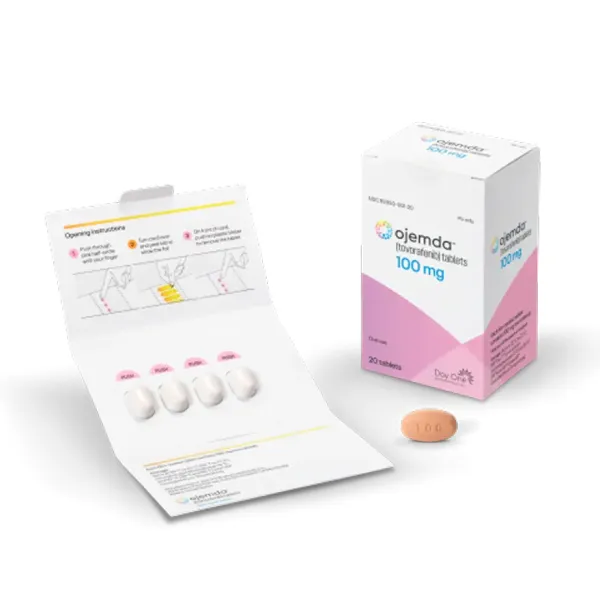Tovorafenib Dosage
Medically reviewed by Drugs.com. Last updated on Jun 6, 2024.
Applies to the following strengths: 100 mg; 25 mg/mL
Usual Adult Dose for:
Usual Pediatric Dose for:
Additional dosage information:
Usual Adult Dose for Malignant Glioma
The recommended dose based on BSA is 380 mg/m2 orally once a week
Recommended immediate release tablet dosage based on BSA:
BSA 0.30 to 0.89 m2: Administer oral suspension once a week.
BSA 0.90 to 1.12 m2: 400 mg orally once a week
BSA 1.13 to 1.39 m2: 500 mg orally once a week
BSA 1.40 m2 or greater: 600 mg orally once a week
Recommended oral suspension dosage based on BSA:
BSA 0.30 to 0.35 m2: 125 mg orally once a week
BSA 0.36 to 0.42 m2: 150 mg orally once a week
BSA 0.43 to 0.48 m2: 175 mg orally once a week
BSA 0.49 to 0.54 m2: 200 mg orally once a week
BSA 0.55 to 0.63 m2: 225 mg orally once a week
BSA 0.64 to 0.77 m2: 275 mg orally once a week
BSA 0.78 to 0.83 m2: 300 mg orally once a week
BSA 0.84 to 0.89 m2: 350 mg orally once a week
BSA 0.90 to 1.05 m2: 375 mg orally once a week
BSA 1.06 to 1.25 m2: 450 mg orally once a week
BSA 1.26 to 1.39 m2: 525 mg orally once a week
BSA 1.40 m2 or greater: 600 mg orally once a week
Maximum dose: 600 mg orally once a week
Duration of therapy: Until disease progression or intolerable toxicity.
Comments:
- Before starting treatment, confirm the presence of BRAF fusion or rearrangement, or BRAF V600 mutation.
- The recommended dosage for patients with BSA less than 0.3 m2 has not been established.
Use: For the treatment of patients with relapsed or refractory low-grade glioma harboring a BRAF fusion or rearrangement, or BRAF V600 mutation
Usual Pediatric Dose for Malignant Glioma
6 months or older:
The recommended dose based on BSA is 380 mg/m2 orally once a week
Recommended immediate release tablet dosage based on BSA:
BSA 0.30 to 0.89 m2: Administer oral suspension once a week.
BSA 0.90 to 1.12 m2: 400 mg orally once a week
BSA 1.13 to 1.39 m2: 500 mg orally once a week
BSA 1.40 m2 or greater: 600 mg orally once a week
Recommended oral suspension dosage based on BSA:
BSA 0.30 to 0.35 m2: 125 mg orally once a week
BSA 0.36 to 0.42 m2: 150 mg orally once a week
BSA 0.43 to 0.48 m2: 175 mg orally once a week
BSA 0.49 to 0.54 m2: 200 mg orally once a week
BSA 0.55 to 0.63 m2: 225 mg orally once a week
BSA 0.64 to 0.77 m2: 275 mg orally once a week
BSA 0.78 to 0.83 m2: 300 mg orally once a week
BSA 0.84 to 0.89 m2: 350 mg orally once a week
BSA 0.90 to 1.05 m2: 375 mg orally once a week
BSA 1.06 to 1.25 m2: 450 mg orally once a week
BSA 1.26 to 1.39 m2: 525 mg orally once a week
BSA 1.40 m2 or greater: 600 mg orally once a week
Maximum dose: 600 mg orally once a week
Duration of therapy: Until disease progression or intolerable toxicity.
Comments:
- Before starting treatment, confirm the presence of BRAF fusion or rearrangement, or BRAF V600 mutation.
- The recommended dosage for patients with BSA less than 0.3 m2 has not been established.
Use: For the treatment of patients 6 months of age and older with relapsed or refractory pediatric low-grade glioma (LGG) harboring a BRAF fusion or rearrangement, or BRAF V600 mutation
Renal Dose Adjustments
- Mild to Moderate Renal Dysfunction (estimated GFR [eGFR] 30 mL/min or more): No adjustment recommended
- Severe Renal Dysfunction (eGFR less than 30 mL/min): Unknown
Liver Dose Adjustments
Mild liver dysfunction: No adjustment recommended
Moderate to Severe liver dysfunction: Unknown
Dose Adjustments
Recommended Dosage Reductions for Adverse Reactions:
Immediate release tablets:
- BSA 0.30 to 1.12 m2: Administer the oral suspension once a week.
- BSA 1.13 to 1.39 m2:
- First Dosage Reduction: 400 mg orally once a week
- Second Dosage Reduction: Administer oral suspension once a week.
- BSA 1.40 m2 or greater:
- First Dosage Reduction: 500 mg orally once a week
- Second Dosage Reduction: 400 mg orally once a week
Oral Suspension:
- BSA 0.30 to 0.35 m2:
- First Dosage Reduction: 100 mg orally once a week
- Second Dosage Reduction: 75 mg orally once a week
- BSA 0.36 to 0.42 m2:
- First Dosage Reduction: 125 mg orally once a week
- Second Dosage Reduction: 100 mg orally once a week
- BSA 0.43 to 0.48 m2:
- First Dosage Reduction: 150 mg orally once a week
- Second Dosage Reduction: 125 mg orally once a week
- BSA 0.49 to 0.54 m2:
- First Dosage Reduction: 175 mg orally once a week
- Second Dosage Reduction: 150 mg orally once a week
- BSA 0.55 to 0.63 m2:
- First Dosage Reduction: 200 mg orally once a week
- Second Dosage Reduction: 150 mg orally once a week
- BSA 0.64 to 0.77 m2:
- First Dosage Reduction: 225 mg orally once a week
- Second Dosage Reduction: 200 mg orally once a week
- BSA 0.78 to 0.83 m2:
- First Dosage Reduction: 250 mg orally once a week
- Second Dosage Reduction: 200 mg orally once a week
- BSA 0.84 to 0.89 m2:
- First Dosage Reduction: 300 mg orally once a week
- Second Dosage Reduction: 250 mg orally once a week
- BSA 0.90 to 1.05 m2:
- First Dosage Reduction: 325 mg orally once a week
- Second Dosage Reduction: 275 mg orally once a week
- BSA 1.06 to 1.25 m2:
- First Dosage Reduction: 375 mg orally once a week
- Second Dosage Reduction: 325 mg orally once a week
- BSA 1.26 to 1.39 m2:
- First Dosage Reduction: 450 mg orally once a week
- Second Dosage Reduction: 375 mg orally once a week
- BSA 1.40 m2 or greater:
- First Dosage Reduction: 500 mg orally once a week
- Second Dosage Reduction: 400 mg orally once a week
Recommended Dosage Modifications for Adverse Reactions:
Hemorrhage:
- Intolerable grade 2 or any grade 3 hemorrhage:
- Withhold treatment with this drug.
- If improved to grade 0 to 1, resume at lower dosage.
- If not improved, consider permanent discontinuation of this drug.
- First occurrence of any grade 4 hemorrhage:
- Withhold treatment with this drug.
- If improved to grade 0 to 1, resume at lower dosage or permanently discontinue this drug.
- If recurrent grade 4 hemorrhage occurs, permanently discontinue this drug.
Skin Toxicity including Photosensitivity:
- Intolerable grade 2 to 4 skin toxicity:
- Withhold treatment with this drug.
- If improved to grade 0 to 1, resume at lower dosage.
- If not improved, consider permanent discontinuation of this drug.
Hepatotoxicity:
- Grade 3 AST or ALT or grade 3 bilirubin:
- Withhold treatment with this drug.
- If improved to grade 2 or baseline resume as follows:
- If laboratory abnormality resolves within 8 days, resume this drug at the same dose.
- If laboratory abnormality does not resolve within 8 days, resume this drug at lower dose.
- First occurrence of any grade 4 adverse reactions:
- Withhold treatment with this drug.
- If improved to grade 0 to 1, resume at lower dosage or permanently discontinue this drug.
- If recurrent grade 4 adverse reactions occur, permanently discontinue this drug.
Other Adverse Reactions:
- Intolerable grade 2 or any grade 3 adverse reactions:
- Withhold treatment with this drug.
- If improved to grade 0 to 1, resume at lower dosage.
- If not improved, consider permanent discontinuation of this drug.
- First occurrence of any grade 4 adverse reactions:
- Withhold treatment with this drug.
- If improved to grade 0 to 1, resume at lower dosage or permanently discontinue this drug.
- If recurrent grade 4 adverse reactions occur, permanently discontinue this drug.
Precautions
CONTRAINDICATIONS: None
Safety and efficacy have not been established in patients younger than 6 months.
Consult WARNINGS section for additional precautions.
Dialysis
Data not available
Other Comments
Administration advice:
- Before starting treatment, evaluate liver function tests, including ALT, AST, and bilirubin.
- Administer the drug at a regularly scheduled time once a week, with or without food.
- If a dose is missed by 3 days or less, take it immediately and take the next dose on its regularly scheduled day.
- If a dose is missed by more than 3 days, skip it, and take the next dose on its regularly scheduled day.
- If vomiting happens shortly after taking a dose, repeat that dose.
- Swallow tablets whole with water. Do not chew, cut, or crush.
- Administer the oral suspension using the supplied oral dosing syringe or feeding tube (minimum 12 French).
- Suspension must be used immediately after reconstitution.
- If the oral suspension is not administered within 15 minutes of preparation, it should be discarded.
Storage requirements:
- Store at 20C to 25C (68F to 77F). Excursions are permitted between 15C to 30C (59F to 86F).
Reconstitution techniques:
- Reconstitute the powder with 14 mL of room temperature water.
- After reconstitution, each milliliter of oral suspension contains 25 milligrams of this drug.
- Product foaming after reconstitution reduces the deliverable volume.
- Each bottle delivers 300 mg of this drug in 12 mL.
- For doses greater than 300 mg, reconstitute two bottles to achieve the dose.
General:
- This indication is approved under accelerated approval based on response rate and duration. Continued approval may be contingent upon verification and description of clinical benefit in a confirmatory trial(s).
- The US FDA approved test for the detection of BRAF fusion or rearrangement, or BRAF V600 mutation in relapsed or refractory pediatric low-grade glioma is not currently available.
Monitoring:
Hematologic: Hemorrhage
Hepatic: Liver function (prior to and during therapy)
Other: Growth velocity
Patient advice:
- Read the US FDA-approved patient labeling (Patient Information and Instructions for Use).
- This drug can cause hemorrhage, contact your healthcare provider if signs or symptoms of bleeding occur.
- This drug can cause skin toxicities, contact your healthcare provider if you experience worsening or intolerable rash.
- This drug can cause photosensitivity, limit direct ultraviolet exposure during treatment by using precautionary measures like sunscreen, sunglasses, and protective clothing.
- This drug can cause liver toxicity, contact your healthcare provider if signs or symptoms of liver dysfunction occur. Serum liver tests (ALT, AST, and bilirubin) should be done on a regular basis during treatment.
- Patient growth will be monitored during treatment with this drug since it may reduce growth velocity.
- Breastfeeding is not recommended during treatment and for 2 weeks after the last dose.
- This drug has the potential to impair fertility in both males and females with reproductive potential.
- Patients should contact their healthcare provider if they have a known or suspected pregnancy during treatment since this drug has the potential to cause fetal harm.
More about tovorafenib
- Check interactions
- Compare alternatives
- Side effects
- During pregnancy
- Drug class: multikinase inhibitors
- En español
Patient resources
Other brands
Professional resources
Other brands
Related treatment guides
See also:
Further information
Always consult your healthcare provider to ensure the information displayed on this page applies to your personal circumstances.


